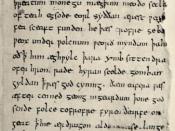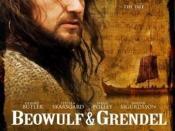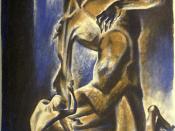The Angles, Saxons, and Jutes invaded England after the Romans left in the fifth century. The poem Beowulf shapes and interprets material connected with the Angles, Saxons, and Jutes. Three elements that help develop the poem Beowulf are imagery, conflict, and characterization.
The story of Beowulf's heroic adventure would not have held the same impact without the brilliant use of imagery. For example, the grotesque description from Beowulf about how Grendel would murder him has amazing imagery. "Gendel will carry our bloody flesh to the moors, crunch on our bones and smear torn scraps of our skin on the walls of his den." That excerpt gives an amazing mental picture and a sense of Grendel's ruthlessness. Without the imagery, Grendel wouldn't seem so callous and Beowulf so brave. Another great example of imagery is when Grendel entered the main hall and carried off thirty warriors. "Snatched up thirty men, smashed them, unknowing in their beds and ran out with their bodies, the blood dripping behind them."
This quote also has great impact on the development of Grendel's character as well as the story. The last example of imagery is used during the battle between Beowulf and Grendel's mother. "Bloody foam on the water of a pool reveals that the thane's body has been carried below to the monster's den. Hideous sea serpents pay about the surface of the water." One can almost feel the thickness of the air with that description. Without imagery, the poem would not have the same impact and the characters wouldn't seem so heroic.
There were many conflicts throughout Beowulf. One conflict was with Unferth and Beowulf. Unferth starts out telling an untrue story about Beowulf that projects him in a negative light. Then Beowulf rebuttals with the fact that Unferth is drunk, and retells...


